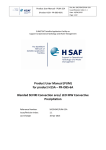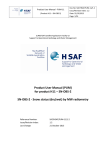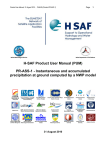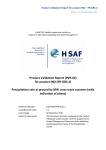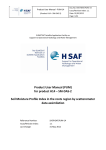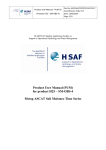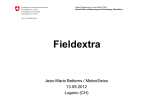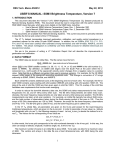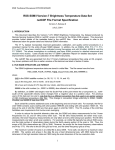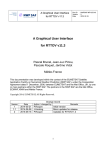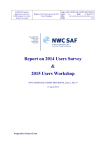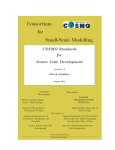Download Product User Manual (PUM) for product H04 – PR-OBS-4 - H-SAF
Transcript
Product User Manual - PUM-04 (Product H04 – PR-OBS-4) Doc.No: SAF/HSAF/PUM-04 Issue/Revision Index: 1.1 Date: 31/05/2012 Page: 1/23 EUMETSAT Satellite Application Facility on Support to Operational Hydrology and Water Management Product User Manual (PUM) for product H04 – PR-OBS-4 Precipitation rate at ground by LEO/MW supported by GEO/IR (with flag of phase) Reference Number: Issue/Revision Index: Last Change: SAF/HSAF/PUM-04 1.1 31 May 2012 Product User Manual - PUM-04 (Product H04 – PR-OBS-4) Doc.No: SAF/HSAF/PUM-04 Issue/Revision Index: 1.1 Date: 31/05/2012 Page: 2/23 DOCUMENT CHANGE RECORD Issue / Revision Date 1.0 20/01/2012 1.1 31/05/2012 Description Baseline version prepared for ORR1 Part 3 Updated release for CDOP2 ORR1 Part3 Close-out: Removal of the discussions on product status (RID 1) Insertion the explanation about precipitation phase (RID3) in section 1.2.5 Explanation about the product specificity (RID1 on PVR04) Improvement of the concept of timeliness, in section 2.1.3 (RID4 on PVR04) Quality information associated to product, now documented in Annex 1 (RID2) Product User Manual - PUM-04 (Product H04 – PR-OBS-4) Doc.No: SAF/HSAF/PUM-04 Issue/Revision Index: 1.1 Date: 31/05/2012 Page: 3/23 INDEX 1 Introduction .............................................................................................................................................. 5 1.1 Purpose of the document .................................................................................................................. 5 1.2 Introduction to product PR-OBS-4..................................................................................................... 5 1.2.1 Principle of sensing .................................................................................................................... 5 1.2.2 Status of satellites and instruments .......................................................................................... 6 1.2.3 Highlights of the algorithm ........................................................................................................ 7 1.2.4 Architecture of the products generation chain ......................................................................... 8 1.2.5 Precipitation phase .................................................................................................................... 8 1.2.6 Product coverage and appearance ............................................................................................ 8 1.2.7 Product specificity ................................................................................................................... 10 2 Product operational characteristics ........................................................................................................ 11 2.1 Horizontal resolution and sampling ................................................................................................ 11 2.1.1 Vertical resolution if applicable ............................................................................................... 11 2.1.2 Observing cycle and time sampling ......................................................................................... 11 2.1.3 Timeliness ................................................................................................................................ 11 3 Product validation ................................................................................................................................... 12 3.1 Validation strategy........................................................................................................................... 12 4 Product availability.................................................................................................................................. 13 4.1 Site ................................................................................................................................................... 13 4.1.1 Directory “products” ................................................................................................................ 13 4.1.2 Directory “from_archive” ........................................................................................................ 13 4.1.3 Directory “utilities” .................................................................................................................. 13 4.2 Formats and codes .......................................................................................................................... 13 4.3 Description of the files .................................................................................................................... 13 Annex 1. PR-OBS-4 Output description ..................................................................................................... 15 Annex 2. Introduction to H-SAF .................................................................................................................. 17 Annex 3. Acronyms ..................................................................................................................................... 22 Product User Manual - PUM-04 (Product H04 – PR-OBS-4) Doc.No: SAF/HSAF/PUM-04 Issue/Revision Index: 1.1 Date: 31/05/2012 Page: 4/23 List of Tables Table 1 Current status of satellites utilised for PR-OBS-4 (as of March 2010) .................................................. 6 Table 2 Main features of SEVIRI ........................................................................................................................ 7 Table 3 Summary instructions for accessing PR-OBS-4 data ........................................................................... 14 Table 4 H-SAF Product List............................................................................................................................... 18 List of Figures Figure 1 Flow chart of the LEO/MW-GEO/IR-blending precipitation rate processing chain............................. 8 Figure 2 Morphing of PMW rain products by using the 183-WSL method (Laviola and Levizzani 2008, 2009) during a severe storm over Southern Italy on 02 October 2009....................................................................... 9 Figure 3 Structure of the Precipitation products validation team .................................................................. 12 Figure 4 Conceptual scheme of the EUMETSAT Application Ground Segment .............................................. 17 Figure 5 Current composition of the EUMETSAT SAF Network (in order of establishment) .......................... 17 Figure 6 Required H-SAF coverage: 25-75°N lat, 25°W - 45°E ......................................................................... 19 Figure 7 H-SAF central archive and distribution facilities................................................................................ 20 Product User Manual - PUM-04 (Product H04 – PR-OBS-4) Doc.No: SAF/HSAF/PUM-04 Issue/Revision Index: 1.1 Date: 31/05/2012 Page: 5/23 1 Introduction 1.1 Purpose of the document Product User Manuals are available for each (pre)-operational H-SAF product, for open users, and also for demonstrational products, as necessary for beta-users. Each PUM contains: Product introduction: principle of sensing, Satellites utilized, Instrument(s) description, Highlights of the algorithm, Architecture of the products generation chain, Product coverage and appearance; Main product operational characteristics: Horizontal resolution and sampling, Observing cycle and time sampling, Timeliness; Overview of the product validation activity: Validation strategy, Global statistics, Product characterisation Basic information on product availability: Access modes, Description of the code, Description of the file structure An annex also provides common information on Objectives and products, Evolution of H-SAF products, User service and Guide to the Products User Manual. Although reasonably self-standing, the PUM’s rely on other documents for further details. Specifically: ATDD (Algorithms Theoretical Definition Document), for extensive details on the algorithms, only highlighted here; PVR (Product Validation Report), for full recount of the validation activity, both the evolution and the latest results. These documents are structured as this PUM, i.e. one document for each product. They can be retrieved from the CNMCA site on HSAF web page at User Documents session. On the same site, to obtain user and password please contact the Help Desk. It is interesting to consult, although not closely connected to this PUM, the full reporting on hydrological validation experiments (impact studies): HVR(Hydrological Validation Report), spread in 10 Parts, first one on requirements, tools and models, then 8, each one for one participating country, and a last Part with overall statements on the impact of H-SAF products in Hydrology. 1.2 Introduction to product PR-OBS-4 1.2.1 Principle of sensing Product PR-OBS-4 is based on the same ingredients of PR-OBS-3, but the blending method is different. Here the basic information is the precipitation rate (supposedly accurate) measured by MW instruments (in the H-SAF case, PR-OBS-1 and PR-OBS-2). The sequence of IR images from the SEVIRI instrument on board Meteosat satellites is used to derive dynamic information (cloud motion). The dynamic information is used to interpolate in between successive MW-derived precipitation fields. In between two successive MWderived precipitation fields it is possible to advect the first field forward and the second one backward, and combine the two. The product is generated at 30-min rate (from the 15-min imaging rate of SEVIRI), and the spatial resolution is consistent with that one of the MW image. Frequent sampling is a prerequisite for computing accumulated precipitation (product PR-OBS-5). The processing method is called “Morphing”. The processing area is the same as for PR-OBS-3 and PR-OBS-5 (see Figure 6). Product User Manual - PUM-04 (Product H04 – PR-OBS-4) Doc.No: SAF/HSAF/PUM-04 Issue/Revision Index: 1.1 Date: 31/05/2012 Page: 6/23 1.2.2 Status of satellites and instruments PR-OBS-4 does not retrieve precipitation from MW sensors. MW-derived precipitation data come from SSM/I and SSMIS (utilised by PR-OBS-1), and AMSU-A and MHS (utilised by PR-OBS-2). The current status of the satellites possibly to be utilised for PR-OBS-4 is shown in next table: Satellite Launch 12 Dec 1999 18 Oct 2003 DMSP-F15 expected 2010 expected 2010 expected 2011 expected 2014 expected 2011 expected 2011 6 Feb 2009 expected 2014 21 Dec 2005 expected 2019 DMSP-F16 DMSP-F17 4 Nov 2006 18 Oct 2009 19 Oct 2006 20 May 2005 DMSP-F18 MetOp A (*) NOAA-18 NOAA-19 End of service Meteosat-9 Height 845 km 855 km 855 km 857 km 817 km 854 km 870 km LST Status Instruments for PROBS-3 05:40 d Secondary Operation SSM/I (defective) 07:10 d Secondary Operation SSMIS 05:30 d Primary Operation SSMIS 07:55 d Primary Operation SSMIS 09:31 d Operational AMSU-A (defective), MHS 13:52 a Operational AMSU-A, MHS 13:43 a Operational AMSU-A, MHS (defective) Operational SEVIRI GEO: 0° (*) Currently not used, waiting for adapting the PR-OBS-2 software to handle the defect of one AMSU-A channel. Table 1 Current status of satellites utilised for PR-OBS-4 (as of March 2010) Descriptions of SSMIS, and of AMSU-A and MHS can be found in the Product User Manuals PUM-01 (on PROBS-1) and PUM-2 (on PR-OBS-2) SEVIRI Spinning Enhanced Visible Infra-Red Imager Satellites Status Mission Instrumenttype Meteosat-8, Meteosat-9, Meteosat-10, Meteosat-11 (i.e., Meteosat Second Generation) Operational - Utilised in the period: 2002 to ~ 2021 Multi-purpose imagery and wind derivation by tracking clouds and water vapour features Multi-purpose imaging VIS/IR radiometer - 12 channels (11 narrow-bandwidth, 1 highresolution broad-bandwidth VIS) N/A (GEO) Full disk every 15 min. Limited areas in correspondingly shorter time intervals 4.8 km IFOV, 3 km sampling for narrow channels; 1.4 km IFOV, 1 km sampling for broad VIS channel Mass: 260 kg - Power: 150 W - Data rate: 3.26 Mbps Scanning technique Coverage/cycle Resolution (s.s.p.) Resources Central wavelength N/A (broad bandwidth channel) 0.635 µm 0.81 µm 1.64 µm 3.92 µm 6.25 µm Spectralinterval(99 % encircledenergy) 0.6 - 0.9 µm 0.56 - 0.71 µm 0.74 - 0.88 µm 1.50 - 1.78 µm 3.48 - 4.36 µm 5.35 - 7.15 µm Radiometric accuracy (SNR or NEΔT) 4.3 @ 1 % albedo 10.1 @ 1 % albedo 7.28 @ 1 % albedo 3 @ 1 % albedo 0.35 K @ 300 K 0.75 K @ 250 K Product User Manual - PUM-04 (Product H04 – PR-OBS-4) 7.35 µm 8.70 µm 9.66 µm 10.8 µm 12.0 µm 13.4 µm 6.85 - 7.85 µm 8.30 - 9.10 µm 9.38 - 9.94 µm 9.80 - 11.8 µm 11.0 - 13.0 µm 12.4 - 14.4 µm Table 2 Main features of SEVIRI Doc.No: SAF/HSAF/PUM-04 Issue/Revision Index: 1.1 Date: 31/05/2012 Page: 7/23 0.75 K @ 250 K 0.28 K @ 300 K 1.50 K @ 255 K 0.25 K @ 300 K 0.37 K @ 300 K 1.80 K @ 270 K 1.2.3 Highlights of the algorithm The baseline algorithm for PR-OBS-4 processing is described in ATDD-04. Only essential elements are highlighted here. The blending technique adopted for PR-OBS-4 is called “Morphing”, developed after the initial work of Joyce et al. 20041. SEVIRI frequent IR images are commonly used to derive cloud system advection vectors. These vectors may not always correlate well with the propagation of the lower precipitating layer of the system, and wind direction changes and wind speed generally increases in magnitude with height from the earth’s surface. However, spatially lagging overlapping 5x5° lat/lon image segments sampled at 2.5 lat/lon intervals provide a good measure of the movement of entire cloud systems. The MW rainfall propagation process begins by spatially propagating initial fields of 8-km half-hourly instantaneous MW analysis estimates, by the discrete distance of the corresponding zonal and meridional vectors. Similar process is applied backward in time when the next MW-derived precipitation field is available. The two coincident determinations, from the forward and the backward processes, are averaged giving weight to the time-distance from the two consecutive MW determinations. 1 Joyce R.J., J.E. Janowiak, P.A Arkin and P. Xie, 2004: “CMORPH: A method that produces global precipitation estimates from passive microwave and infrared data at high spatial and temporal resolution”. J. Hydrometeor., 5, 487-503. . Product User Manual - PUM-04 (Product H04 – PR-OBS-4) Doc.No: SAF/HSAF/PUM-04 Issue/Revision Index: 1.1 Date: 31/05/2012 Page: 8/23 1.2.4 Architecture of the products generation chain The architecture of the PR-OBS-4 product generation chain is shown here below: SSM/I-SSMIS ~ 3-hourly sequence of MW observations Morphing algorithm AMSU-MHS Lookup tables updating SEVIRI 15-min images Rapid-update algorithm PRECIPITATION RATE Extraction of dynamical info Figure 1 Flow chart of the LEO/MW-GEO/IR-blending precipitation rate processing chain Actually, figure above refers to the architecture of the coupled products PR-OBS-3 and PR-OBS-4, that includes: the Rapid Update process based on (frequent) SEVIRI IR images “calibrated” by the (infrequent) MWderived precipitation data as retrieved from SSM/1 and SSMIS (PR-OBS-1) or from AMSU-A and MHS (PR-OBS-2); the Morphing process based on (infrequent) MW-derived precipitation maps, and MW precipitation pseudo-maps interpolated at frequent intervals by exploiting the dynamic information provided by the SEVIRI images. It is noted that, at the time of closing the H-SAF CDOP-1 phase (ORR), PR-OBS-3 makes use of MW precipitation data coming from the PR-OBS-1 chain (SSMIS) since October 2011. 1.2.5 Precipitation phase The flag phase is available in the current version of PR-OBS-1 (H-01), but it is not implemented in the current version of PR-OBS-2 (H-02). Thus, it is not available in the current version of PR-OBS-4 (H-04) which doesn’t make use of the flag phase. Then the cluster is waiting the new release of H02 to switch-on the flag phase in the H04. The flag phase will be available in the new version of the algorithm for H-02, which will be delivered at the end of CDOP1. Thus, the H-04 product will be modified to include the flag phase available from H-01 and H02. It is conceivable that a new validation will be necessary to assess the quality of the results. 1.2.6 Product coverage and appearance A prototype example is provided in figure below: Product User Manual - PUM-04 (Product H04 – PR-OBS-4) Doc.No: SAF/HSAF/PUM-04 Issue/Revision Index: 1.1 Date: 31/05/2012 Page: 9/23 PMW at 01:00 UTC Morphingat 01:30 UTC Morphingat 02:30 UTC Morphingat 03:30 UTC PMW at 04:00 UTC Morphingat 04:30 UTC PMW at 05:00 UTC Morphingat 05:30 UTC Morphingat 06:30 UTC Figure 2 Morphing of PMW rain products by using the 183-WSL method (Laviola and Levizzani 2008, 2009) during a severe storm over Southern Italy on 02 October 2009. Note for figure above: retrieved rain rates at 01:00 UTC are “morphed” up to the new PMW orbit at 05:00 UTC. Morphing results, mapped on the 8 km grid and regularly updated every 30-min, are shown here for a 1-hour resolution time. Note that last two plates are used to describe the CMORPH reconstruction of rain Product User Manual - PUM-04 (Product H04 – PR-OBS-4) Doc.No: SAF/HSAF/PUM-04 Issue/Revision Index: 1.1 Date: 31/05/2012 Page: 10/23 fields between PMW product as at 05:00 UTC and that at 06:30 UTC, not shown here but indicated by red ovals. 1.2.7 Product specificity As expected from literature, and confirmed by the product validation results, the present PR-OBS-4 product is more suitable to detect and estimate low intensity rainfall. The other IR-based H-SAF product, i. e. PROBS-3, is on the contrary more performing in regimes of high rainfall rate (mainly convective events). Product User Manual - PUM-04 (Product H04 – PR-OBS-4) Doc.No: SAF/HSAF/PUM-04 Issue/Revision Index: 1.1 Date: 31/05/2012 Page: 11/23 2 Product operational characteristics 2.1 Horizontal resolution and sampling The horizontal resolution ( x) is the convolution of several features (sampling distance, degree of independence of the information relative to nearby samples, …). To simplify matters, it is generally agreed to refer to the sampling distance between two successive product values, assuming that they carry forward reasonably independent information. The horizontal resolution descends from the instrument Instantaneous Field of View (IFOV), sampling distance (pixel), Modulation Transfer Function (MTF) and number of pixels to co-process for filtering out disturbing factors (e.g. clouds) or improving accuracy. It may be appropriate to specify both the resolution x associated to independent information, and the sampling distance, useful to minimise aliasing problems when data have to undertake resampling (e.g., for co-registration with other data). In PR-OBS-4, the effective resolution is controlled by the MW-derived products, PR-OBS-1 and PR-OBS-2, therefore a figure representative of the PR-OBS-4 resolution is: x ~ 30 km. However, the “morphing” procedure operates on a fixed grid (sampling distance) of ~ 8 km intervals, close to the SEVIRI IFOV over Europe. 2.1.1 Vertical resolution if applicable The vertical resolution ( z) also is defined by referring to the vertical sampling distance between two successive product values, assuming that they carry forward reasonably independent information. The vertical resolution descends from the exploited remote sensing principle and the instrument number of channels, or spectral resolution. It is difficult to be estimated a-priori: it is generally evaluated a-posteriori by means of the validation activity. [Note: in H-SAF, the only product with vertical structure is SM-ASS-1, Volumetric soil moisture]. 2.1.2 Observing cycle and time sampling The observing cycle ( t) is defined as the average time interval between two measurements over the same area. The composite observing cycle of PR-OBS-1 + PR-OBS-2 over Europe is about 3 h. MW-derived precipitation fields are interpolated by using dynamical information from SEVIRI. Since conceptually the process is governed by the availability of two consecutive rain products, PR-OBS-4 will be run when at least two of the rain products PR-OBS-1 and/or PR-OBS-2 will be stored, therefore the observing cycle is t ~ 3 h. [Note: this will occur when PR-OBS-1 will be utilised in addition to PR-OBS-2]. Interpolated maps are available at30 minintervals (sampling time). 2.1.3 Timeliness The timeliness ( )is defined as the time between observation taking and product available at the user site assuming a defined dissemination mean. The timeliness depends on the satellite transmission facilities, the availability of acquisition stations, the processing time required to generate the product and the reference dissemination means. For PR-OBS-4, the algorithm starts every hour (with or without the new MW precipitation map). At the time T it works between 2 MW precipitation maps one at T-2hrs and the second at T-1hrs. Assuming processing time is 3-4 minutes and dissemination time is 1-2 minutes, conclusion is: timeliness ~ 120 min Product User Manual - PUM-04 (Product H04 – PR-OBS-4) Doc.No: SAF/HSAF/PUM-04 Issue/Revision Index: 1.1 Date: 31/05/2012 Page: 12/23 3 Product validation 3.1 Validation strategy Whereas the previous operational characteristics have been evaluated on the base of system considerations (number of satellites, their orbits, access to the satellite) and instrument features (IFOV, swath, MTF and others), the evaluation of accuracy requires validation, i.e. comparison with the ground truth or with something assumed as “true”. PR-OBS-4, as any other H-SAF product, will be submitted during the CDOP-2 to validation entrusted to a number of institutes (see figure below). Precipitation products validation group Leader: Italy (DPC) Belgium IRM Germany Hungary Italy Poland Slovakia BfG OMSZ UniFe IMWM SHMÚ Figure 3 Structure of the Precipitation products validation team Turkey ITU Precipitation data will be compared with rain gauges and meteorological radar. Before undertaking comparison, ground data and satellite data will be submitted to scaling and filtering procedures. Two streams of activities will be carried out: evaluation of general statistics (multi-categorical and continuous), to help in identifying existence of pathological behaviour selected case studies, useful in identifying the roots of such behaviour. Product User Manual - PUM-04 (Product H04 – PR-OBS-4) Doc.No: SAF/HSAF/PUM-04 Issue/Revision Index: 1.1 Date: 31/05/2012 Page: 13/23 4 Product availability 4.1 Site PR-OBS-4 will be available via EUMETCast (when authorized) and via FTP (after log in). The current access is via FTP at the following site: URL: ftp://ftp.meteoam.it to obtain user a password please contact the Help Desk. In the FTP site there are three relevant directories: products, for near-real-time dissemination; from_archive, for previous months; utilities, for providing decoding tools. 4.1.1 Directory “products” In this directory the products appear shortly after generation, consistently with the “timeliness” requirement. They are kept available for nominally 1-2 months, often more. Quick-looks of the latest 3-5 PR-OBS-4 maps, covering some H-SAF areas, can be viewed on the H-SAF web site http://hsaf.meteoam.it 4.1.2 Directory “from_archive” Currently “from_archive”. This directory holds the data of the previous months. 4.1.3 Directory “utilities” This directory provides tools to decode and manage the digital data. 4.2 Formats and codes Three type of files are provided for PR-OBS-4: the digital data, coded in GRIB2; the image-like maps, coded in PNG. In the directory “utilities”, the folder Grib_decode provides the instructions for reading the digital data. 4.3 Description of the files Current data Directory: products Sub-directory: h04 Two folders: - h04_cur_mon_grb - h04_cur_mon_png Past data Directory: from_archive Sub-directory:h04 Monthlydouble sub-folders: h04_yyyymm_grb Product User Manual - PUM-04 (Product H04 – PR-OBS-4) Doc.No: SAF/HSAF/PUM-04 Issue/Revision Index: 1.1 Date: 31/05/2012 Page: 14/23 h04_yyyymm_png In both directories products and reprocess the files have identical structures. Next table summarises the situation and provides the information on the file structure, including the legenda. URL: ftp://ftp.meteoam.it Directory: products - username: to contact the Help Desk Product identifier: h04 h04_cur_mon_grb h04_cur_mon_png Files description (for both directories) yyyymm: yyyymmdd: hhmm: password: to contact the Help Desk Directory: from_archive - Product identifier: h04 h04_yyyymm_grb data of current months h04_yyyymm_png data of previous months h04_yyyymmdd_hhmm_rom.grb.gz digital data h04_yyyymmdd_hhmm_rom.png image data year, month year, month, day hour and minute of last scan line (northernmost) Table 3 Summary instructions for accessing PR-OBS-4 data Product User Manual - PUM-04 (Product H04 – PR-OBS-4) Annex 1. Doc.No: SAF/HSAF/PUM-04 Issue/Revision Index: 1.1 Date: 31/05/2012 Page: 15/23 PR-OBS-4 Output description PR-OBS-4 quality index is encoded as a GRIB2 (please refer to WMO GRIB2 format documentation available at www.wmo.int), with the following keys: GRIB2 /* gribSection0 */ /* 3 = Space products (grib2/0.0.table) */ discipline,3 editionNumber,2 /* section 1 */ /* 80 = Rome (RSMC) (grib1/0.table) */ identificationOfOriginatingGeneratingCentre,80 identificationOfOriginatingGeneratingSubCentre,0 /* 3 = Current operational version number implemented on 2 November 2005 (grib2/1.0.table) */ gribMasterTablesVersionNumber,3 /* 0 = Local tables not used (grib2/1.1.table) */ versionNumberOfGribLocalTables,0 /* 3 = Observation time (grib2/1.2.table) */ significanceOfReferenceTime,3 year, month, day, hour, minute, second, /* 2 = Research products (grib2/1.3.table) */ productionStatusOfProcessedData,2 /* 6 = Processed satellite observations (grib2/1.4.table) */ typeOfProcessedData,6 /* 0 = Specified in Code table 3.1 (grib2/3.0.table) */ sourceOfGridDefinition,0 numberOfDataPoints,500000 numberOfOctetsForOptionalListOfNumbersDefiningNumberOfPoints,0 /* 0 = There is no appended list (grib2/3.11.table) */ interpretationOfListOfNumbersDefiningNumberOfPoints,0 /* 0 = Latitude/longitude. Also called equidistant cylindrical, or Plate Carree (grib2/3.1.table) */ gridDefinitionTemplateNumber,0 /* 6 = Earth assumed spherical with radius of 6,371,229.0 m (grib2/3.2.table) */ shapeOfTheEarth,6 scaleFactorOfRadiusOfSphericalEarth,0 scaledValueOfRadiusOfSphericalEarth,0 scaleFactorOfMajorAxisOfOblateSpheroidEarth,0 scaledValueOfMajorAxisOfOblateSpheroidEarth,0 scaleFactorOfMinorAxisOfOblateSpheroidEarth,0 scaledValueOfMinorAxisOfOblateSpheroidEarth,0 Ni,1000 Nj",500 basicAngleOfTheInitialProductionDomain,0 Product User Manual - PUM-04 (Product H04 – PR-OBS-4) Doc.No: SAF/HSAF/PUM-04 Issue/Revision Index: 1.1 Date: 31/05/2012 Page: 16/23 subdivisionsOfBasicAngle,0 latitudeOfFirstGridPoint",59963614 longitudeOfFirstGridPoint",-25064672 latitudeOfLastGridPoint",23650697 longitudeOfLastGridPoint",47619240 iDirectionIncrement",72756 jDirectionIncrement",72771 /* 48 = 00110000 (3=1) i direction increments given (4=1) j direction increments given (5=0) Resolved u- and v- components of vector quantities relative to easterly and northerly directions See grib2/3.3.table */ resolutionAndComponentFlags,48 /* 0 = 00000000 (1=0) Points of first row or column scan in the +i (+x) direction (2=0) Points of first row or column scan in the -j (-y) direction (3=0) Adjacent points in i (x) direction are consecutive (4=0) All rows scan in the same direction See grib2/3.4.table */ scanningMode,0 /* grib 2 Section 4 PRODUCT DEFINITION SECTION */ numberOfCoordinatesValues,0 /* 30 = Satellite product (grib2/4.0.table) */ productDefinitionTemplateNumber,30 /* 0 = Image format products (grib2/4.1.3.table) */ parameterCategory,0 /* 192 = Reserved for local use (grib2/4.2.3.0.table) */ parameterNumber,192 /* 192 = Reserved for local use (grib2/4.3.table) */ typeOfGeneratingProcess,192 /* grib 2 Section 5 DATA REPRESENTATION SECTION */ numberOfValues",500000 /* 0 = Grid point data - simple packing (grib2/5.0.table) */ dataRepresentationTemplateNumber,0 decimalScaleFactor",0 numberOfBitsContainingEachPackedValue,8 /* 0 = Floating point (grib2/5.1.table) */ typeOfOriginalFieldValues,0 /* grib 2 Section 6 BIT-MAP SECTION */ /* 0 = Bit map is present in this product (grib2/6.0.table) */ bitMapIndicator,0 missingValue",0.0 /* grib 2 Section 7 data */ /* grib 2 Section 8 END */ Product User Manual - PUM-04 (Product H04 – PR-OBS-4) Annex 2. Doc.No: SAF/HSAF/PUM-04 Issue/Revision Index: 1.1 Date: 31/05/2012 Page: 17/23 Introduction to H-SAF The EUMETSAT Satellite Application Facilities H-SAF is part of the distributed application ground segment of the “European Organisation for the Exploitation of Meteorological Satellites (EUMETSAT)”. The application ground segment consists of a “Central Application Facility (CAF)” and a network of eight “Satellite Application Facilities (SAFs)” dedicated to development and operational activities to provide satellite-derived data to support specific user communities. See next figure: EUM Geostationary Systems Systems of the EUM/NOAA Cooperation Data Acquisition and Control other data sources Data Processing EUMETSAT HQ Application Ground Segment Meteorological Products Extraction EUMETSAT HQ Archive &Retrieval Facility (Data Centre) EUMETSAT HQ Centralised processing and generation of products Satellite Application Facilities (SAFs) Decentralised processing and generation of products USERS Figure 4 Conceptual scheme of the EUMETSAT Application Ground Segment Next figure reminds the current composition of the EUMETSAT SAF network (in order of establishment). Nowcasting& Very ShortRange Forecasting Ocean and Sea Ice Ozone & Atmospheric Chemistry Monitoring Climate Monitoring Numerical Weather Prediction GRAS Meteorology Land Surface Analysis Operational Hydrology & Water Management Figure 5 Current composition of the EUMETSAT SAF Network (in order of establishment) H-SAF objectives and products The H-SAF was established by the EUMETSAT Council on 3 July 2005;its Development Phase started on 1stSeptember 2005 and ended on 31 August 2010. The SAF is now in its first Continuous Development and Operations Phase (CDOP) which started on 28 September 2010 and will end on 28 February 2012. The H-SAF objectives are: a. to provide new satellite-derived productsfrom existing and future satellites with sufficient time and space resolution to satisfy the needs of operational hydrology; identified products: Product User Manual - PUM-04 (Product H04 – PR-OBS-4) Doc.No: SAF/HSAF/PUM-04 Issue/Revision Index: 1.1 Date: 31/05/2012 Page: 18/23 precipitation; soil moisture; snow parameters; b. to perform independent validation of the usefulness of the new productsfor fighting against floods, landslides, avalanches, and evaluating water resources; the activity includes: downscaling/upscaling modelling from observed/predicted fields to basin level; fusion of satellite-derived measurements with data from radar and raingauge networks; assimilation of satellite-derived products in hydrological models; assessment of the impact of the new satellite-derived products on hydrological applications. This document (the PUM, Product User Manual) is concerned only with the satellite-derived products. The list of products to be generated by H-SAF is shown in next table: Acronym Identifier Name PR-OBS-1 H-01 Precipitation rate at ground by MW conical scanners (with indication of phase) PR-OBS-2 H-02 Precipitation rate at ground by MW cross-track scanners (with indication of phase) PR-OBS-3 H-03 Precipitation rate at ground by GEO/IR supported by LEO/MW PR-OBS-4 H-04 Precipitation rate at ground by LEO/MW supported by GEO/IR (with flag for phase) PR-OBS-5 H-05 Accumulated precipitation at ground by blended MW and IR PR-OBS-6 H-15 Blended SEVIRI Convection area/ LEO MW Convective Precipitation PR-ASS-1 H-06 Instantaneous and accumulated precipitation at ground computed by a NWP model SM-OBS-2 H-08 Small-scale surface soil moisture by radar scatterometer SM-OBS-3 H-16 Large-scale surface soil moisture by radar scatterometer SM-DAS-2 H-14 Soil Moisture Profile index in the roots region by scatterometer assimilation method SN-OBS-1 H-10 Snow detection (snow mask) by VIS/IR radiometry SN-OBS-2 H-11 Snow status (dry/wet) by MW radiometry SN-OBS-3 H-12 Effective snow cover by VIS/IR radiometry SN-OBS-4 H-13 Snow water equivalent by MW radiometry Table 4 H-SAF Product List The work of precipitation products generation is shared in the H-SAF Consortium as follows: Precipitation products (pre-fix: PR) are generated in Italy by the CNMCA, in its premises at Pratica di Mare (Rome). CNMCA also manages the Central Archive and the Data service. CNR develops and upgrades the algorithm. Product User Manual - PUM-04 (Product H04 – PR-OBS-4) Doc.No: SAF/HSAF/PUM-04 Issue/Revision Index: 1.1 Date: 31/05/2012 Page: 19/23 Product coverage Figure of this section shows the required geographic coverage for H-SAF products. Figure 6 Required H-SAF coverage: 25-75°N lat, 25°W - 45°E This area is fully covered by the Meteosat image (although the resolution sharply decreases at higher latitudes) each 15 min. For polar satellites, the area is covered by strips of swath approximately 1500 km (conical scanners) or 2200 km (cross-track scanners) at about 100 min intervals. Swaths intercepting the acquisition range of direct-read-out stations provide data in few minutes; for swaths outside the acquisition range the delay may be several tens of minutes if the satellite/instrument data are part of the EARS / EUMETCast broadcast, some hours otherwise (e.g., by ftp).The time resolution (observing cycle) is controlled by the number of satellites concurring to perform the observation, and the instrument swath. Data circulation and management Next figure shows the data circulation scheme in H-SAF. All products from the generating centres are concentrated at CNMCA (except that certain can go directly to the user by dedicated links: example, GTS, Global Telecommunication System connecting operational meteorological services). From CNMCA the data are sent to EUMETSAT to be broadcast by EUMETCast in near-real-time. Product User Manual - PUM-04 (Product H04 – PR-OBS-4) Doc.No: SAF/HSAF/PUM-04 Issue/Revision Index: 1.1 Date: 31/05/2012 Page: 20/23 H-SAF Archive EDC Client EUMETSAT Data Centre EUMETSAT EUMETCastHQ area H-SAF Products generation centres Dedicated links H-SAF Products users Figure 7 H-SAF central archive and distribution facilities All data also go to the H-SAF Archive where they can be accessed through the EUMETSAT Data Centre via a Client. Therefore, the H-SAF products may be accessed: via EUMETCast in near-real-time (primary access mode); off-line via the EUMETSAT Data Centre (most common access mode for the scientific community). It is noted that this scheme is valid only for operational products. For products in development disseminated to beta-users only, or demonstrational products, the distribution ordinarily utilises the ftp servers of the product generation centres, or the CNMCA server. CNMCA also re-disseminate the products generated in other centres, therefore all products can be retrieved from the CNMCA server. The ftp dissemination stream will continue to be active even after the EUMETCast dissemination becomes effective, both for redundancy purpose, and for users not equipped for EUMETCast reception. The H-SAF web site The address of the H-SAF web site is:http://hsaf.meteoam.it/. The web site provides: - general public information on H-SAF - H-SAF products description - rolling information on the H-SAF implementation status - an area for collecting/updating information on the status of satellites and instruments used in H-SAF - an area to collect Education and Training material - an area for “forums” (on algorithms, on validation campaigns, etc.) - indication of useful links (specifically with other SAF’s) - an area for “Frequently Asked Questions” (FAQ) to alleviate the load on the Help desk. The web site supports operations by providing: - daily schedule of H-SAF product distribution - administrative messages on changes of product version (new algorithms, etc.). Product User Manual - PUM-04 (Product H04 – PR-OBS-4) Doc.No: SAF/HSAF/PUM-04 Issue/Revision Index: 1.1 Date: 31/05/2012 Page: 21/23 The web site contains some basic H-SAF documents (the ATDD, Algorithms Theoretical Definition Document; this Product User Manual, …). However, most working documents (REP-3: Report of the Products Validation Programme; REP-4: Report of the Hydrological Validation Programme; etc.), programmatic documents (PP: Project Plan; URD: User Requirements Documents; etc.) and engineering documents are to be found in the CNMCA ftp server (restricted access; see later for the URL). The User Support For any question that cannot be solved by consulting the web site, users have two different possibilities: - To send an email through the “Contact Us” functionality of the web-site, in charge of forwarding the request to an help desk. This functionality is also available to unregistered users ; - To compose a specific question/request to the help-desk available only to registered users; in this case, the user should specify in the “Subject” one of the following codes: MAN PRE SOM SNO HYD ARC GEN (management) (precipitation) (soil moisture) (snow) (hydrology) (archive) (general). Condition for use of H-SAF products All H-SAF products are owned by EUMETSAT, and the EUMETSAT SAF Data Policy applies. They are available for all users free of charge. Users should recognise the respective roles of EUMETSAT, the H-SAF Leading Entity and the H-SAF Consortium when publishing results that are based on H-SAF products. EUMETSAT’s ownership of and intellectual property rights into the SAF data and products is best safeguarded by simply displaying the words “© EUMETSAT” under each of the SAF data and products shown in a publication or website. Product User Manual - PUM-04 (Product H04 – PR-OBS-4) Annex 3. AMSU AMSU-A AMSU-B ATDD AU BfG CAF CDOP CESBIO CM-SAF CNMCA CNR CNRS DMSP DPC EARS ECMWF EDC EUM EUMETCast EUMETSAT FMI FTP GEO GRAS-SAF HDF HRV H-SAF © IDL IFOV IMWM IPF IPWG IR IRM ISAC ITU LATMOS LEO LSA-SAF LST Météo France METU MHS MSG MVIRI MW NEΔT NESDIS NMA NOAA NWC-SAF NWP NWP-SAF Doc.No: SAF/HSAF/PUM-04 Issue/Revision Index: 1.1 Date: 31/05/2012 Page: 22/23 Acronyms Advanced Microwave Sounding Unit (on NOAA and MetOp) Advanced Microwave Sounding Unit - A (on NOAA and MetOp) Advanced Microwave Sounding Unit - B (on NOAA up to 17) AlgorithmsTheoretical Definition Document Anadolu University (in Turkey) Bundesanstalt für Gewässerkunde (in Germany) Central Application Facility (of EUMETSAT) Continuous Development-Operations Phase Centre d'EtudesSpatiales de la BIOsphere (of CNRS, in France) SAF on Climate Monitoring Centro Nazionale di Meteorologia e Climatologia Aeronautica (in Italy) Consiglio Nazionale delle Ricerche (of Italy) Centre Nationale de la Recherche Scientifique (of France) Defense Meteorological Satellite Program Dipartimento Protezione Civile (of Italy) EUMETSAT Advanced Retransmission Service European Centre for Medium-range Weather Forecasts EUMETSAT Data Centre, previously known as U-MARF Short for EUMETSAT EUMETSAT’s Broadcast System for Environmental Data European Organisation for the Exploitation of Meteorological Satellites Finnish Meteorological Institute File Transfer Protocol Geostationary Earth Orbit SAF on GRAS Meteorology Hierarchical Data Format High Resolution Visible (one SEVIRI channel) SAF on Support to Operational Hydrology and Water Management Interactive Data Language Instantaneous Field Of View Institute of Meteorology and Water Management (in Poland) Institut für Photogrammetrie und Fernerkundung (of TU-Wien, in Austria) International Precipitation Working Group Infra Red Institut Royal Météorologique (of Belgium) (alternative of RMI) Istituto di Scienze dell’Atmosfera e del Clima (of CNR, Italy) İstanbulTechnicalUniversity (in Turkey) Laboratoire Atmosphères, Milieux, Observations Spatiales (of CNRS, in France) Low Earth Orbit SAF on Land Surface Analysis Local Satellite Time (if referred to time) or Land Surface Temperature (if referred to temperature) National Meteorological Service of France Middle East TechnicalUniversity (in Turkey) Microwave Humidity Sounder (on NOAA 18 and 19, and on MetOp) Meteosat Second Generation (Meteosat 8, 9, 10, 11) Meteosat Visible and Infra Red Imager (on Meteosat up to 7) Micro Wave Net Radiation National Environmental Satellite, Data and Information Services National Meteorological Administration (of Romania) National Oceanic and Atmospheric Administration (Agency and satellite) SAF in support to Nowcasting& Very Short Range Forecasting Numerical Weather Prediction SAF on Numerical Weather Prediction Product User Manual - PUM-04 (Product H04 – PR-OBS-4) O3M-SAF OMSZ ORR OSI-SAF PDF PEHRPP Pixel PMW PP PR PUM PVR RMI RR RU SAF SEVIRI SHMÚ SSM/I SSMIS SYKE TBB TKK TMI TRMM TSMS TU-Wien U-MARF UniFe URD UTC VIS ZAMG Doc.No: SAF/HSAF/PUM-04 Issue/Revision Index: 1.1 Date: 31/05/2012 Page: 23/23 SAF on Ozone and Atmospheric Chemistry Monitoring Hungarian Meteorological Service Operations Readiness Review SAF on Ocean and Sea Ice Probability Density Function Pilot Evaluation of High Resolution Precipitation Products Picture element Passive Micro-Wave Project Plan Precipitation Radar (on TRMM) Product User Manual Product Validation Report Royal Meteorological Institute (of Belgium) (alternative of IRM) Rain Rate Rapid Update Satellite Application Facility Spinning Enhanced Visible and Infra-Red Imager (on Meteosat from 8 onwards) Slovak Hydro-Meteorological Institute Special Sensor Microwave / Imager (on DMSP up to F-15) Special Sensor Microwave Imager/Sounder (on DMSP starting with S-16) Suomen ympäristökeskus (Finnish Environment Institute) Equivalent Blackbody Temperature (used for IR) Teknillinen korkeakoulu (Helsinki University of Technology) TRMM Microwave Imager (on TRMM) Tropical Rainfall Measuring Mission UKMO Turkish State Meteorological Service Technische Universität Wien (in Austria) Unified Meteorological Archive and Retrieval Facility University of Ferrara (in Italy) User Requirements Document Universal Coordinated Time Visible Zentralanstalt für Meteorologie und Geodynamik (of Austria)























